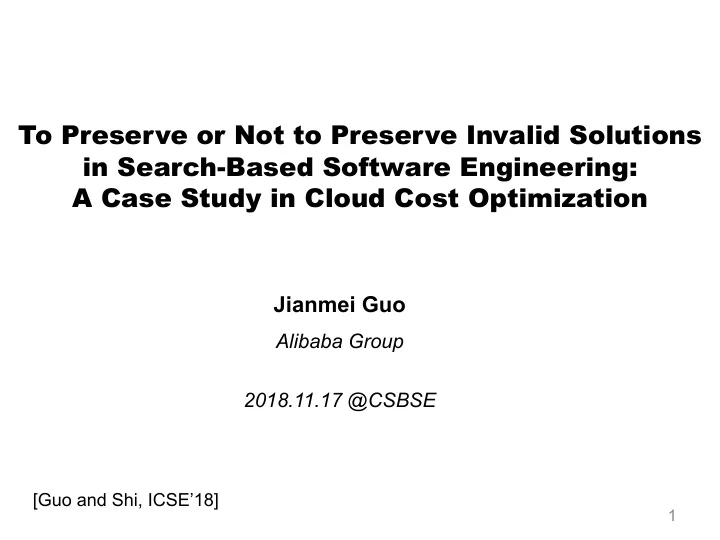

To Preserve or Not to Preserve Invalid Solutions in Search-Based Software Engineering: A Case Study in Cloud Cost Optimization Jianmei Guo Alibaba Group 2018.11.17 @CSBSE [Guo and Shi, ICSE’18] 1
Search-based software engineering (SBSE) 2
Search-based software engineering (SBSE) Should we preserve invalid solutions during the search? 3
Outline • A case study in software produce lines (SPLs) – SPL optimization problem – Five algorithm variants based on the state-of-the-art – Seven real-world subjects ( a particular one in cloud cost optimization ) • Three potential limitations of preserving invalid solutions • Empirical guidance on how to preserve valid solutions – How to choose the population for performance evaluation? – Should we keep valid solutions in the initial population? – Should we fix invalid solutions after mutation? – Should we preserve valid solutions all along the way? – Should we preserve invalid solutions during the search? 4
SPL Optimization Problem 5
SPL Optimization Problem A multi-objective combinatorial optimization problem 6
Five Algorithm Variants • Multi-objective evolutionary algorithms (MOEAs) – IBEA [Sayyad et al., ICSE’13, ASE’13] – SATIBEA [Henard et al., ICSE’15] 7
Five Algorithm Variants • Multi-objective evolutionary algorithms (MOEAs) – IBEA [Sayyad et al., ICSE’13, ASE’13] – SATIBEA [Henard et al., ICSE’15] Mutation Probability of using SAT Type of initial rate solving for mutation population 8
Five Algorithm Variants • Multi-objective evolutionary algorithms (MOEAs) Preserving validity “all along the way” by incorporating a subroutine that resolves non-Boolean constraints over integer or real-number variables together with arithmetic or relational operators 9
Seven Subjects • Five largest SPLs hitherto reported in the literature • Two SPLs with realistic values and constraints of attributes [Henard et al., ICSE'15] [Sánchez et al., Software & Systems Modeling, 2017] [García-Galán et al., Future Generation Comp. Syst., 2016] 10
Potential Limitations – 1/3 • Ratios of invalid solutions in the final populations produced by state-of-the-art approaches IBEA [Sayyad et al., ICSE’13, ASE’13] SATIBEA [Henard et al., ICSE’15] 11
Potential Limitations – 2/3 Performance evaluation depends mainly on the metrics calculated on the population produced Ø Including invalid solutions Ø Excluding invalid solutions SATIBEAv1 SATIBEA 12
Potential Limitations – 3/3 Amazon Elastic Compute Cloud (EC2) Excerpted from [García-Galán et al., 2016] 13
Empirical Guidance – 1/5 How to choose the population for performance evaluation? • Inconsistent results when including and excluding invalid solutions in the population • Invalid solutions are unbuildable and thus useless in practice Considering only valid solutions, at least , in the final population 14
Empirical Guidance – 2/5 Should we keep valid solutions in the initial population? • Empirical results cannot statistically distinguish three algorithms adopting different initial populations in terms of any quality metric • SATIBEA is the least and the easiest to build Using random strategy to generate the initial population 15
Empirical Guidance – 3/5 Should we fix invalid solutions after mutation? • Experimental results on six subjects demonstrate the superiority of SATIBEA among three algorithms adopting different mutation operators. Adopting a lower mutation rate (0.001) and a lower probability (0.02) to fix a solution to be valid after mutation 16
Empirical Guidance – 4/5 Should we preserve valid solutions all along the way? • Valid solutions must be preserved all along the way for AmazonEC2 • For the other subjects without attribute constraints, SATIBEA works better for 4 out of 6 subjects. Preserving valid solutions all along the way might not always be necessary. 17
Empirical Guidance – 5/5 Should we preserve invalid solutions during the search? Whether or not to preserve invalid solutions deserves more attention in SBSE, and in some cases, we have to preserve valid solutions all along the way during the search. 18
Conclusion • Open question : Should we preserve invalid solutions during the search? • Three potential limitations of preserving invalid solutions – No guarantee to produce valid solutions – Evaluation results might be misleading – Complex attribute constraints break the fitness calculation based on simple aggregation • Empirical guidance on how to preserve valid solutions – Considering only valid solutions, at least, in the final population for evaluation – Using random strategy to generate the initial population – Adopting a lower mutation rate and a lower probability to fix a solution to be valid – Preserving valid solutions all along the way might not always be necessary • Take-home message : Whether or not to preserve invalid solutions deserves more attention in SBSE, and in some cases, we have to preserve valid solutions all along the way during the search. • See paper for: – Detailed experimental setup and results – Threats to validity & Future work 19
Thanks for your attention! https://github.com/jmguo/balanceValidity/ 20
Recommend
More recommend